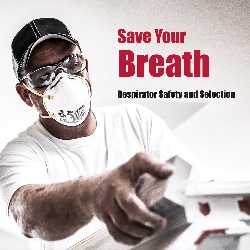Respirator. It makes you breathe harder just thinking about it – it can be uncomfortable, hot, stuffy, you name it. But it can save your life at the same time. The best respirator suppliers take into account that people won’t wear one if it makes them miserable, and progress has been substantial. We took a deep breath and spoke with Jason Lunn, a knowledgeable fellow about such things; he’s a 3M senior application engineer for safety, build, and repair.
If someone says “go get me a respirator,” it’s just like someone saying “get something chocolate” – without more information you’ll get the wrong thing, so you’ll want to ask some questions of your crew chief, your paint supplier, or in this case Jason Lunn as to how to come back with the right one.
“First, it depends on what kind of painting you are doing,” he said. “Rolling or brushing may not require a respirator since it may not produce an airborne mist like spraying does.
“Spraying produces a particulate mist so you would need to consider a particle filter to help reduce your exposure. Some paints also give off a vapor, which requires activated carbon to help filter those chemical odors. For low VOC (volatile organic compound) paints in well-ventilated spaces, vapor levels are often low,” he continued, “so it may be sufficient to use a disposable respirator with a layer of carbon embedded in it to help with both the particulates from the mist and the odor in the chemical component.”
If you’re using a more traditional paint with higher levels of VOCs, and/or in less ventilated spaces, your airborne concentrations will likely be higher, which can require a different type of respirator. “In this case,” says Lunn, “consider at least a half-face or full-face reusable respirator with organic vapor cartridges and a particulate pre-filter. Keep in mind, spraying in confined spaces may even require oxygen monitoring and more sophisticated respirator options altogether.”
If a paint is “green” or lower-VOC, it may be less hazardous than traditional paint formulations, but there are other potentially hazardous ingredients that shouldn’t be ignored, he points out. “You still need to do your due diligence and check the safety data sheet for other potentially hazardous materials, as well as assess your overall work environment, before determining what respiratory protection is needed.”
Brought to You by the Letter N
There’s always going to be that go-to, the one you’ll use most of the time, and those are the pieces you’ll want your crew to have on hand (and on face). Once you determine that right product for a job you do “all the time,” it should be an easy fit, so to speak. Just like once you figure out that favorite chocolate bar, life becomes that much easier.
“A half facepiece reusable respirator with organic vapor cartridges and particulate pre-filter may cover the majority of your painting applications,” Lunn suggested, explaining how it helps. “When selected and used properly, organic vapor cartridges can help reduce exposure to most organic compounds (such as VOCs), which are what give paint its recognizable odor, and the particle filter can help reduce exposure to the particulate components such as talc and titanium dioxide that can be found in the mist created from spraying.”
The disposable N95, he adds, is a great product to have on hand for paint prep, such as sanding drywall or wood, as it will help reduce exposure to the airborne dust and debris. “The benefits of a disposable respirator include that it’s lightweight, easy to breathe through and can be overall more comfortable than a reusable respirator. They’re also great for use for shorter-duration projects and require no maintenance, meaning you can replace them quickly and easily once they become dirty, damaged or difficult to breathe through.”
Approval of Seal
No one likes that man behind the mustache telling you to shave – and a quick look at Jason’s LinkedIn shows he’s no stranger to a razor – but when it comes to respirators, fit matters and hair can get in the way. “Some people are not aware of just how important the respirator seal to the face is,” says Jason. “But the truth of the matter is both disposable and reusable respirators need to create an effective seal to work as intended. It doesn’t matter if you buythe broadest spectrum gas/vapor cartridge or the most efficient particle filter, if you don’t get a good seal to the face, the respirator won’t function as intended.”
That’s some sad news for guys with beards – unless you’re in a position to delegate the spraying to someone else. Lunn recommends a clean-shaven face to ensure a good fit. “You may have seen workers with beards wearing tight-fitting respirators on the jobsite, but that doesn’t mean it’s okay,” he said. “Facial hair can certainly interfere with the seal to the face.” Even a five o’clock shadow can break that seal, allowing hazardous contaminants to enter through gaps between the respirator and face. “Ironically,” he added, “a break in the seal may lead you to believe the respirator isn’t working, when in fact you simply don’t have a good seal because of facial hair.”
Another oft-misunderstood issue, he adds, is how to form a noseclip on a disposable respirator. If you’ve been pinching the clip with only one hand… well… stop. “This can cause the noseclip to form a crease above the nose, creating a gap that could allow for contaminants to enter the respirator during inhalation and could also contribute to fogging of safety glasses during exhalation. To properly form the noseclip,” Jason instructs, “use your fingertips from both hands to slowly mold the clip around the nose starting at the bridge and moving downward. Taking your time with this step will help ensure a more secure seal.” And of course, you’ll look awesome.
One Size Doesn’t Fit All
Lunn acknowledges what everyone knows – if it doesn’t fit, no one’s going to force it. “When a respirator is hot, uncomfortable and potentially contributing to fogging of safety glasses, workers may be tempted to take it off and forgo using it, exposing themselves to the hazard.” Therefore, a good fit is important – if it doesn’t fit correctly it might not function as needed, and if it doesn’t fit comfortably, it’ll stay in the truck or at the store. “The better a respirator fits and the more comfortable it is, the more likely the worker will wear the product and wear it longer, helping to keep them compliant, more protected and more productive because they’re focused on the project at hand rather than their ill-fitting and uncomfortable respirator.”
To that end, Jason gave us some tips on a comfortable fit, to help us all breathe easy. “Reusable respirators often come in different sizes (usually small, medium and large) to help accommodate the wide range of facial shapes and sizes. They also come in different facepiece materials, such as silicone and thermoplastic elastomer, which can affect comfort as well as fit.”
If you’re going for disposable, you may need to try several different models to see what fits your face best – it’s not gym socks where one pair reputedly fits size 6 to 11. “Disposable respirators offer a variety of different features that can help improve comfort, such as exhalation valves, foam faceseals, uniquely shaped noseclips, braided headbands and even adjustable straps,” Lunn points out. “If you find that a traditional cup style isn’t fitting you well, consider a flat fold disposable respirator to see if that style provides a better fit to your face.”
In any case, take it as seriously as a reusable product. “To determine which size and model of respirator fits your face correctly, you must go through a fit test to ensure the chosen respirator can effectively keep a good seal on your face throughout a variety of movements.”
As thanks, we might just send Jason some chocolate, but… we don’t know what he likes.





Add new comment